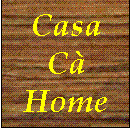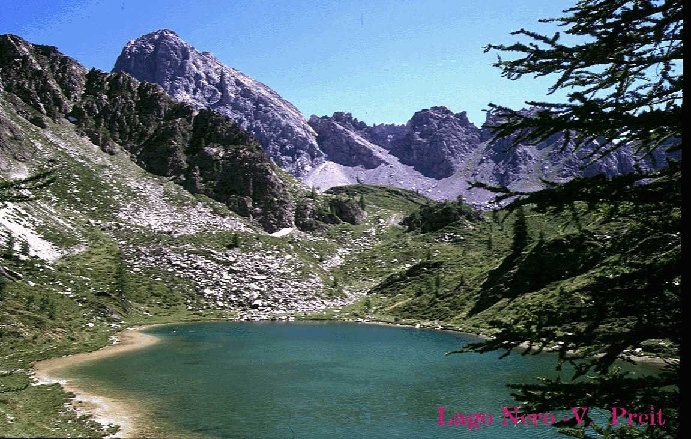


Piedmontese Grammar
We note that among substantive with fixed gender, some are masculine in Piedmontese and feminine in Italian, and viceversa. This happen both with substantives having different root and then different derivation, and with substantive having the same root and the same latin derivation. Here we give a little exemple of these two groups.
Substantives that are masculine in Piedmontese and feminine in Italian
| Piedmontese (masculine) | ....Italian (feminine).... | ..........English ........... |
| amson | mietitura | harvesting |
| armognan | albicocca | apricot |
| ars˛rt | molla | spring |
| autin | vigna | vineyard |
| bÓuti | altalena | swing |
| b˛sch | legna | wood |
| botal | botte | barrel |
| bornel | doccia | shower |
| brassab˛sch | edera | ivy |
| cotin | gonna | skirt |
| crajon | matita | pencil |
| foet | frusta | whip |
| ludvich | allodola | skylark |
| mantil | tovaglia | table-cloth |
| mërlip˛ | salvia | sage |
| papÚ | carta | paper |
| persi | pesca (fruit) | peach |
| pocio | nespola | medlar |
| pom | mela | apple |
| pruss | pera | pear |
| rid˛ | tendina | curtain |
| ruso | ruggine | rust |
| tuf | afa | sultriness |
Substantives that are feminine in Piedmontese and masculine in Italian
| Piedmontese (feminine) | ....Italian (masculine).... | ..........English ........... |
| alvÓ | lievito | yeast |
| aquarela | acquerello | watercolour |
| Ómpola | lampone | raspberry |
| arbra | pioppo | poplar |
| braje | pantaloni | trousers |
| (la) cÓud | (il) caldo | (the) hot |
| coefa | velo | veil |
| ciadeuvra | capolavoro | masterpiece |
| crija | bando | proclamation |
| crosiera | incrocio | crossing |
| drugia | letame | dung |
| doja | boccale | jug |
| fÓuda | grembo | lap, womb |
| (la) fior | (il) fiore | (the flower |
| (la) frŔid | (il) freddo | (the) cold |
| (la) fum | (il) fumo | (the) smoke |
| giassa | ghiaccio | ice |
| (la) matin | (il) mattino | (the) morning |
| manten-a | corrimano | handrail |
| pÓuta | fango | mud |
| (la) resta | (il) resto | (the) change |
| )la) sal | (il) sale | (the) salt |
| sigala | sigaro | cigar |
| (la) seugn | (il) sonno | (the) sleep |
| trýfola | tartufo | truffle |
| tign˛la | gelone | chilblain |
About the number of nouns, we note some piedmontese substantive which have only the plural form, but have a singular meaning:
- le ross˛le = the measles (in Piedmontese also the associated werb is plural)
- le vair˛le = the smallpox
- j'ampromŰttiure = the engagement, the betrothal
- le batiaje = the baptism
- etc.
As a last observation we consider the masculine substantive "capitani" which is invariant in number. Its meaning is "captain", and it is both singular and plural, even if the form is plural. Just for information we report the military ranks in Piedmontese (reference: italian army):
- soldÓ
- caporal
- caporalmagior
- sergent
- sergentmagior
- maressial (ordinari)
- maressial cap
- maressialmagior
- sot-tenent
- tenent
- capitani
- magior
- tenent colonÚl
- colonÚl
- general Űd brigÓ
- general Űd divison
- general Űd c˛rp d'armÓ
Altered nouns
In Piedmontese, as it is in Italian, nouns can be alterated to introduce the idea of "little" (diminutive), of "graceful" (terms of endearment), of "big" (augmentative) and of "bad" (pejorative). This is obtained by means of opportune desinences. First of all we give the translation of the terms:
- English -----> Piedmontese
- Altered nouns -----> N˛m auterÓ
- Diminutive -----> Diminutiv
- Term of endearment ----> Carëssativ
- Augmentative ---> Chërsativ
- Pejorative ----> Dispresiativ
- Altered nouns -----> N˛m auterÓ
Diminutive (Diminutiv)
In Piedmontese the used desinences are:
For masculine "...et, ...in" which are invariant at plural
For feminine "...ëtta, ...eta, ...in-a" for singular and "...ëtte, ...ete, ...in-e" for plural
The desinence, as a rule, substitutes the last vowel or, if the noun ends by consonant, is simply added to the noun. The origin of the desinence "...eta" is provençal. In some words there are euphonical variations. These variations are in accordance with the piedmontese formation rules of the words. So we have:
- gal = cock ---> galet = cockerel, little cock
- fieul = boy, young man ---> fiolin = little boy, little young man
- banca = bench ---> banchŰtta = little bench, garden seat
- p˛rta = door ---> portin-a = little door
- vi˛la = violet -> violŰtta or violeta = little violet
- etc.
- paireul = paiolo ---> (copper) pot = little pot
- etc.
Terms of endearment (Carëssativ)
In Piedmontese the used desinences are:
For masculine "...˛t, ...˛to, ...ucio, ...uss, ...in" which are invariant at plural
For feminine "...˛ta, ...ucia, ...ussa, ...in-a" for singular and "...˛te, ...uce, ...usse, ...in-e" for plural
We note that the desinences "...in, ...in-a" are also diminutive, and, in general there is a sort of interchangeability among the two sets. Some examples:
- paisan-a = woman farmer ---> paisan˛ta = graceful woman farmer
- vÚj = old man ---> vej˛to = pleasant, quiet old man
- gat = cat ---> gatuss = pussy(-cat)
- etc.
- pocionin = dear little tresor, or similar (appellation between persons in love - literally it could be: little medlar).
- etc.
Augmentative (Chërsativ)
In Piedmontese the used desinence is:
For masculine "...on" which is invariant at plural
For feminine "...on-a" for singular and "...on-e" for plural
In the following examples we note that if the word ends by consonant the desinence is just added, while if the word ends by vowel the desinence substitutes the ending vowel.
- cit = child (male) ---> citon = big child
- cita = child (female) ---> citon-a = big child, big young girl
- etc.
Pejorative (Dispresiativ)
In Piedmontese the used desinences are:
For masculine "...ass, ...astr, ...um" which are invariant at plural
For feminine "...assa, ...astra, ...am, ...aja" for singular and "...asse, ...astre, ...aje" for plural
The desinences "...um, ...am, ...aja, ...aje" have a collective sense, and are used for collective nouns.
- paisan = farmer ---> paisanass = a rude person
- gent = people ---> gentaja = rabble
- mare = mother ---> marastra = stepmother
- etc.
- bon˛m = simple-minded man ---> bonomass = a good simple man
- etc.
Composite alterations
It is possible to associate two alterations in order to obtain particular "effects". The most usual associations are diminutive + term of endearment and Augmentative + Pejorative
The first composite alteration induces the idea of "little and graceful", and uses the desinences:
For masculine "...in˛t, ...etin, ...ëttin, ...inin, ...otin", which are invariant at plural.
For feminine "...in˛ta, ...etin-a, ...ëttin-a, ...inin-a, ...otin-a" at singular and "...in˛te, ...etine, ...inin-e, ...otin-e" at plural.
The second composite alteration induces the idea of "bad and big", and uses the desinences:
For masculine "...asson, ...onass", which are invariant at plural.
For feminine "...asson-a, ...onassa" at singular and "...asson-e, ...onasse" at plural.
Some examples of these composite alterations:
- m˛ra = brunette ---> moretin-a = nice and little brunette
- fija = girl ---> fijëttin-a = nice and little girl
- crin = pig ---> crinasson = bad and dirty man
- ˛m = man ---> omasson = man big and tall (non necessarily in negative sense)
- etc.
Irregular alterations
Nouns ending with a stressed "...Ó" insert an euphonical "...d..." between root and desinence and keep the "...a". The same happens for names ending by stressed "...˛" (grave accent). In this case, since the stress moves to desinence, the "˛" becomes "o" and the pronounciation changes from \ o \ to \ u \.
Nouns ending by stressed "...Ú" (acure accent) insert an euphonical "...r..." between root and desinence and keep the "...e".
Examples:
- s-ciairÓ = a look ---> s-ciairadin-a = a little quick look
- ci˛ = nail ---> ciodin = little nail
- bergÚ = shepherd -> berger˛t = little shepherd (boy)
- etc.
- sgiaf = slap ---> sgiaflon = violent slap
- f˛l = stupid ---> folaton = big stupid
- masnÓ = child, baby (invariant in gender and number) ---> masnaj˛ta = little, nice child (m. and f.) ---> masnaj˛te = little, nice children (m. and f.)
- strÓ = street ----> straj˛la = narrow street
- etc.
- r˛ch \ r'ok \ = stone ---> rocon \ ruc'u[ng] \ = big stone (the "h" is lost)
- baricc \ b&r'i[ch] \ = squint ---> bariciass \ b&ri[ch]'&s \ = badly squint (a "c" is lost and a "i" is added)
- man \ m&[ng] \ = hando -> man¨cia \ m&n'[ue][ch]i& \ = little hand (the "n" does not change)
- etc.
False alterations
As it is also in Italian, there are words that appear as altered forms of other words, but they aren't. For example:
The piedmontese word cassa has some meanings: "hunting, cash, counter, ladle". The word "cassin-a" is nothing referred to something little, since the meaning is "farm".
In the same way, the word "baron" does not indicate a large bar but is a "baron" (as in English) or a "heap, mass, stack"
Diminutives that change root
As in many other languages, in Piedmontese the diminutive of some words is a different word, and sometimes there are different diminutives. So:
"beu" = "ox" ; a little ox is a "vitÚl" or also a "vailet"
"vaca" = "cow" ; a little cow is a "vitela
And so on.
The nouns Madama, Madamin, T˛ta, Mons¨, Sgnor, Sgnora
Once in Piedmont there was the partiarchal family, as it was everywhere. Often it happened that when a girl got married, she went to live in the house of her husband. This was true in particular in the country, connected to the necessity of the agricultural work, but also in the cities often the young couple hadn't the possibility of finding an own house. As a consequence the new family was "included" in the one of the husband. In those times the wife assumed the surname of the husband, and so, the same surname of her mother-in-law.
This latter was the master of the house and (let's suppose a common piedmontese surname : Pautass) she became, with the marriage of her son, Madama Pautass. The new entry, wife of the son of Madama Pautass, being at a lower level assumed the name of Madamin Pautass. The daughter of madamin Pautass once grown up some years would have become T˛ta Pautass (t˛ta = miss) and she would have remained t˛ta Pautass up to her marriage. If she didn't get married, she remained t˛ta all the life long.
When a "t˛ta" reached the age in which it became difficult to find a husband, speaking about her (when she was absent) someone started to call her "toton" (which is, effectively, the augmentative of "tota" and, maliciously, becomes of masculine gender). In English and in Italian there is not the piedmontese difference between Madama and Madamin. Both are Madam in English and Signora in Italian.
For the masculine, the correspondent of Madama, Madamin, T˛ta is unique and is "Mons¨" which is the non confidential form of referring to a person, and corresponds to the english "Mister" or the italian "Signor(e)". The italian word "signore" is also referred to distinction, importance, richness, nobility. In English there are terms like "gentleman, sir, lord". In Piedmontese this meaning is expressed with "Sgnor, Sgnora" (\s[gn]'ur\ \ s[gn]'ur&\) respectively for masculine and feminine, that is referred also to noble mindedness. The appellation Signor is usually reserved to God.
So there are expressions like: "Madama Pautass a l'Ú pr˛pi na sgnora. = Ms. Pautass is realy a gentlewoman", or "Sgnor avocat, mons¨ Pautass a ciÓma Űd vŰdd-Ve = Sir (the) lawyer, mister Pautass asks for seeing you". About this we note that in classical Piedmontese, the way of respect to speak to an important or elderly person is to use "Voi" = (you - plural -). For usual not confidential relations "ChiŔl, chila" = (he, she) is used. Then, for confidential relations the "Ti" = (you - singular -, thou) is used.
We still will speak about this in Syntax.
Translation of surnames
Since the Piedmontese is not recognized by Italy as a language, necessarily the Piedmontese surnames are expressed in an italian (legal) form. But always, in Piedmont surnames have been translated according to the piedmontese rules of derivation, and adapted to the piedmontese tongue. These rules are the same for which a latin word became a piedmontese word (as we've seen before). So we have that...
- Rossi, Rosso becomes Ross (pron. \ rus \)
- Manzoni, Manzone becomes Manson (pron. \ m&[ng]zu[ng] \)
- Rizzotto, Rizzotti becomes Ris˛t (pron. \ rizot \)
- Quaglia becomes Quaja (pron. \ [qu]&y& \)
- Cappello, Capello becomes CapÚl (pron. \ c&p'el \)
- Pautasso becomes Pautass (pron. \ p&ut'&s \)
- etc.
The (first) names
We give some piedmontese names of person, starting from the italian and english form:
| .......................Italian....................... | ......................English...................... | .................Piedmontese.................. |
| Caterina | Catherine | Catlin-a |
| Giovanni Giovanna | John Jane | Gioan Gioan-a |
| Francesco | Francis | FransŔsch |
| Pietro, Piero | Peter | Pero |
| Giuseppe Giuseppino (Pino) | Joseph, Joe | Giusep dimin.= Giuspin (Pino, Pinin, Pin˛t) |
| Giacomo Giacomino | James, Jim | Giaco dimin.= Giacolin |
| Lucia | Lucy | Lussýa |
| Giorgio | George | Gi˛rs |
| Tommaso | Thomas | TomÓ |
| Luigi | Louis | Luis |
| Bartolomeo | Bartholomew | BŰrtromÚ dimin.= Tromlin |
| Margerita | Margaret | Margrita dimin.= Margritin, Ghitin |
| Maddalena | Magdalene Maud | MadlŔn-a dimin.= Madlinin |
| Carlo | Charles | Carlo dimin.= Carl¨cio |
| Vittorio | Victor | Vit˛rio short = T˛jo |
| Camillo | ---- | Camilo short = Milo |
| Lorenzo, Renzo | Lawrence | Lorens, Rens |
The place names
Not only piedmontese places have a piedmontese noun, but also the main places in the worl have a piedmontese name or, at least, a piedmontese pronunciation of the name, when this coincides with the name in local or italian language. About this we note that the name of the city of Turin has been changed only in Italian, where becomes Torino. In French, English, German, and Piedmontese the name is Turin. The piedmontese pronunciation is \ t[ue]r'i[ng] \, in French the pron. is \ t[ue]r'Š[ng] \, in German the pron. is \ t'uri[ng] \, in English the pron. is \ ti'uri[ng] \.
Not all the places that we report have an english name and besides, an english person usually can find (e.g. on a map) only italian names (remember that italian government does not want to recognize the Piedmontese), so we give the italian and the piedmontese name. When there is also the english name, we give also it.
| .......................Italian....................... | ......................English...................... | .................Piedmontese.................. |
| Vercelli | ---- | VersŔj (pr. \ vŠrs'Šy \) |
| Cuneo | ---- | Coni (pr. \ c'uni \) |
| Asti | ---- | Ast (pr. \ &st \) |
| Lanzo | ---- | Lans (pr. \ l'&[ng]s \) |
| Alessandria | ---- | Lissandria (pr. \ lis'&ndri& \) |
| Bardonecchia | ---- | BardonÚcia (pr. \ b&rdun'e[ch]i& \) |
| Venezia | Venice | VenÚssia (pr. \ ven'esi& \) |
| Napoli | Neaples | NÓpoli (pr. \ n'&puli \) |
| Parigi | Paris | Paris (pr. \ p&r'iz \) |
| Lione | Lyon | Lion (pr. \ li'u[ng] \) |
| Berlino | Berlin | Berlin (pr. \ bærl'i[ng] \) |
Two notes:
1) - In Turin the cathedral is entitled to Saint John the Baptist, and, for all in Turin, that is the "Cesa 'd San Gioan" = "Church of St. John", or more simply "the D˛m" = "the Cathedral". But in Turin there is also the church and annexed Salesian Institute of Saint John the Evangelist. For all, in Turin, this is the "Cesa 'd San Gioanin" = "Church of St. Little John" and this is also the common appellative of the related Salesian Institute. About this we remember that the founder of Salesians, Sait John B˛sco in Turin is simply called "Don B˛sch".
2) - The piedmontese name "Pero" = "Peter" is not used for indicating Saint Peter, which is translated into "San PÚ" The name PÚ is not used as a first name.
For other particularities see the Syntax.

